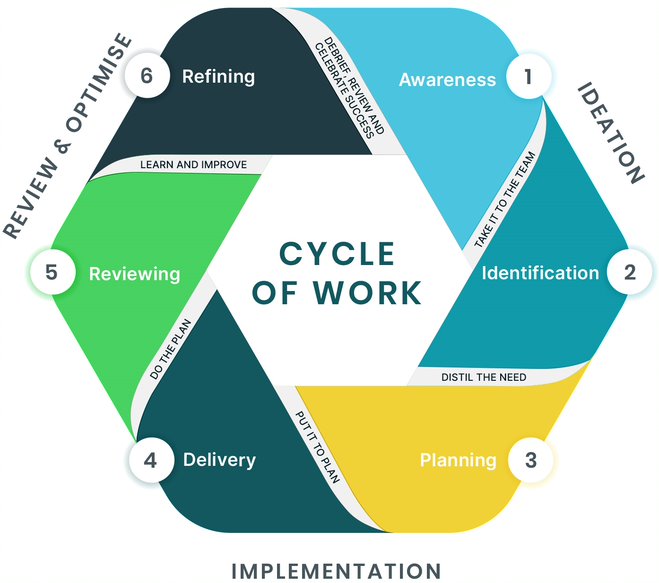
As organisations navigate new ways of working digitally, understanding the cycle of work is essential to deliver innovative and successful work. ASI Solutions has developed an easy-to-implement, six-step methodology to help businesses embrace technology solutions and gain maximum value. This methodology supports organisations to achieve the best outcomes.
This blog series explores the various phases within the cycle of work methodology and highlights the ways organisations can benefit from a more strategic approach to digital work.
Step 2: The cycle of work: identifying new business solutions
Once your business has completed the awareness phase, you should have a clear idea of the idea, opportunity, or question to be addressed. The next step is to identify the issues that surround the initial idea or problem and start to understand how the issue fits into your business’s existing goals and challenges.
One of the main challenges in this stage of the cycle is that many organisations don’t seek enough information to thoroughly identify all aspects of the issue. This can mean that the solution you develop doesn’t account for all the relevant factors, so it may not be effective or deliver the return on investment you were expecting.
Identifying more pieces of the puzzle
To avoid this, it’s important to start getting input from all of the people who may be affected in some way by this issue or solution. This means deep-diving into the challenge at hand and identifying surrounding issues. You can do this through internal sources such as your own sales information, customer feedback including Net Promoter Scores (NPS), or your enterprise resource planning (ERP) solution. You can also use external sources such as third-party data, social media sentiment, or customer reviews on online review pages.
It’s important to use as much hard data as possible. Then, through comprehensive research and discussions, the project team and organisation can make sure everyone clearly understands the problem or opportunity before moving on to potential answers or solutions.
However, this can be challenging when teams aren’t working in the same location and need to work together to share information and ideas. Fortunately, putting the right technology in place can make this almost as seamless as it was when everyone was working in the same office.
For example, many teams like to use whiteboards to collaborate, which was easy when they were working in physical meeting rooms with actual whiteboards. Many people think that working in that way is harder or more complicated now that some people are in the office and others are working at home or other locations. However, there are collaboration tools that make the experience feel almost as real as the in-person one, while still letting team members contribute from different locations.
For example, Microsoft Teams includes an inbuilt Teams whiteboard that works just like a physical whiteboard. This lets the team brainstorm and capture notes and discussion points as seamlessly as they could in person.
Seamless integration between Teams and other applications like SharePoint also means people can share documents directly in the virtual meeting for more detailed discussions. And, they can share their screen to show information from other third-party applications or data sources.
The right technology at the right time
If you use the right technology, which includes the latest collaborative capabilities, then your teams won’t miss opportunities to collaborate and open, blue-sky discussions can still happen regardless of where team members are working.
In the identification phase, this can include:
- Microsoft Power BI to aggregate and analyse additional data
- Microsoft Teams, Whiteboard, and Surface Hub to hold brainstorming sessions and record notes and outcomes
- Microsoft OneNote to capture opinions, ideas, and discussion points
- Microsoft Dynamics CRM and Microsoft Purview to further examine customer insights based on behaviour and sentiments.
Where to from here?
Awareness and identification are just the first two steps that make up the ideation phase in a broader cycle of work. To learn more about the cycle of work and what comes next in the ASI Solutions methodology for modern work habits and practices, download the eBook.
ASI Solutions aligns directly with Microsoft’s vision of empowering every person and organisation to achieve more. ASI Solutions can coach your business to deliver each step of the cycle of work so you can achieve optimum outcomes. To find out more about how ASI Solutions can help you embrace the modern cycle of work, contact the team today.

